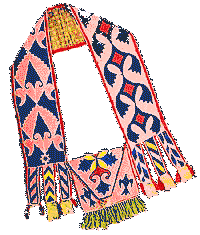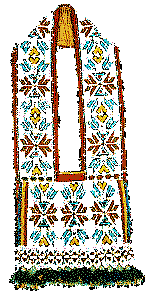Potawatomi, Winnebago, Others -- 1870 - 1890
 |
This unusual geometric design is on a bandolier beaded around 1880 by a Potawatomi artist. It is for sale at the expensive Morningstar Gallery in Santa Fe. No further info is available about it. Potawatomi and Odawa along with Ojibwe are the "Thre Fires" peoples, called that because on the Migration from the East, these 3 groups lit fires together for the last time, before splittling up to go separate ways, at Sault St. Marie (Bow-e-tig, as William Warren recorded it in 1853).
|
|
| Orange (or, as the dealer calls it, pumpkin) beads form the background of this Potawatomi bandolier said to have been made around 1880 and for sale from Morningstar Gallery. Though the photo is too low-rsolution to show th bads, small gometric patterns like this are invariably loom-woven beadwork, both pouch body and strap, here.
|
 |
|
|---|
 |
This is a Loom-woven Potawatomi bandolier, made around 1870, according to Morningstar Gallery.
|
|
|---|
 |
Tribe of the maker and date made are not identified for this Woodland bandolier -- probably late 19th cntury. It is on display at the Wheelwright Museum in Arizona, part of the Manoogan collection. It looks rather different from dance bandoliers -- too short a strap, too small a pouuch -- so it may have been made for sale or as an honor gift. |
|
|---|
| Ho-Chunk (Winnebago) are credited with this loom-beaded bandolier, dated 1885 by Morningstar Gallery. They lived in the Great Lakes Woodland area (until some were forced out to a Nebraska reservation) but are a Siouan-speaking people, not Algonquian. They probably learned of the bandoliers as honor and friendship gifts. |
 |
BANDOLIER Start Page
 BEADS Menu
BEADS Menu
Text and graphics copyright 1995, 1996.
CREDITS: The 3 Potawatomi and the Winnebago bags are from Morning Star Gallery a very pricey place in Santa Fe. The unidentified pink bag is on a page announcing an exhibition (but providing no web exhibits) for Wheelright Museum's Plains and Great Lakes Indian art exhibition.
Last Updated: Monday, August 26, 1996 - 7:01:00 PM AM





